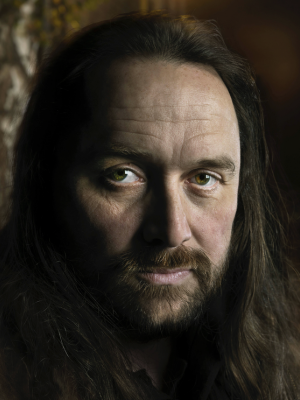
Painter and installation artist. Franz Ackermann (German, 1963) was born in Neumarkt-St. Veit. From 1984 to 1988 he studied at the Academy of Fine Arts in Munich, then from 1989 to 1991 at the Academy of Fine Arts in Hamburg under Bernhard Blume. In the 1990s, he began his Mental Maps series. These small-format watercolor or gouache sketches were created during stays and trips all over the world: on the bus, in a hotel room, on a park bench or in the studio. The papers show almost realistic architectural views, biomorphic ornamentation and cartographic elements mixed with abstract, garish areas of color and geometric constructions. Ackermann combines these mental maps with photographs and found objects to create large-format installations. His mural Die große Reise (2003) can be seen in Munich's Georg-Brauchle-Ring subway station. His works can often be understood as critical and political commentaries on the themes of tourism and globalization, such as African Diamond, a sculpture in the shape of a diamond covered with abstracted map sections of Africa. Ackermann has been Professor of Painting at the Karlsruhe Art Academy since 2001.
His works have been shown in the White Cube gallery in London, the Stedelijk Museum in Amsterdam and the Museum of Modern Art in New York, among others. Franz Ackermann lives and works in Rädigke.
In 1991, Franz Ackermann received a DAAD scholarship that enabled him to make his first trip to Asia and spend a year in Hong Kong. Since then, traveling has become an integral part of his work and he experiments with practices inspired by situational deviance and psychogeography. Ackermann uses photographs taken during the trip and sketches in pencil, ink and watercolor to create mental maps. They are not mimetic reproductions of the territory, but a synthesis of the physical and mental world. From this, he creates dizzying accumulations of bright colors that confront the viewer with a collapsed perspective of pictorial, geographical and architectural space. His artistic network spreads out like a root, a structure sprawling in all directions without a hierarchical system of order. The collages and ornaments seem to follow a chaotic and dynamic energetic force that is set free by gravity in its compulsion to expand. Images and traces of memories of urban explorations often emerge. Cities as spatial, but also mental orientations within an urban network; urban structure as a model for cultural and social reference systems. For Ackermann, the journey and the experiences he lives through are part of the creative process. Although world travel is hardly a 20th century invention, let alone a 21st century one, tourism is a particularly contemporary way of life in the modern world. We are now faced with a multitude of travel options. Yet despite the more enlightened, less imperialistic forms of travel available to us today, and in full knowledge of their economic importance for developing countries, Ackermann explores the question of what exactly it means to participate in the global economy.
Franz Ackermann (born 1963 in Neumarkt St. Veit) lives and works in Karlsruhe and Berlin, Germany. Ackermann has held numerous international exhibitions, including major solo shows at PIFO Gallery (Beijing, 2019), Dirimart (Istanbul, 2017/2012), Berlinische Galerie (Berlin, 2013), Faena Arts Center (Buenos Aires, 2012) and Kunstmuseum Bonn (2009). ), Kunstmuseum St. Gallen (2008), Irish Museum of Modern Art (Dublin, 2005), Museo Nacional Centro de Arte Reina Sofia (Madrid, 2003), Kunsthalle Basel (2002), Stedelijk Museum (Amsterdam, 2002), Museum of Contemporary Art of Chicago (2002), Castello di Rivoli (Turin, 2000) and Portikus (Frankfurt/Main, 1997).
A small selection of important group exhibitions includes the Kunsthalle Bremen (2020), the CAFA Art Museum (Beijing, 2017), the Mildred Lane Kemper Art Museum (St. Louis, 2016/2011), the 2nd Montevideo Biennial (2014) and the Tate Triennial ( 2009), Whitney Museum of American (2006), Neue Nationalgalerie, Berlin (2006), Biennale d'art contemporain de Lyon (2005) and Museo de Arte Moderno (Mexico City, 2002).
Franz Ackermann was awarded the art prize of the city of Nordhorn in 1997 and the “mfi Preis Kunst am Bau” in 2005 for the redesign of the Munich subway station “Georg-Brauchle-Ring” (2003). Ackermann has created public installations at the Miami Beach Convention Center, the Dallas Cowboys Stadium in Arlington, the Georg-Brauchle-Ring subway station in Munich, the Federal Constitutional Court in Karlsruhe and the Federal Chancellery (Berlin). In addition, his works are part of numerous public and private collections such as the MoMA Collection, the Denver Art Museum, the FRAC Champagne Ardenne, the Boros Collection, the Irish Museum of Modern Art, the Castello di Rivoli, the Kunstmuseum Liechtenstein and the Kunsthalle Karlsruhe.
1963: Born in Neumarkt St. Veit, Germany
1984 - 1988: Academy of Fine Arts, Munich, Germany
1989 - 1991: Academy of Fine Arts, Hamburg, Germany
DAAD, Hong Kong
